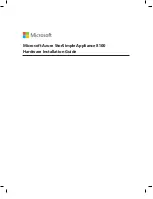
DES-6500 Chassis-based Layer 3 Ethernet Switch Manual
171
Neighbor Router
The OSPF router ID for the remote router. This is a 32-bit number in the form of an IP
address (xxx.xxx.xxx.xxx) that uniquely identifies the remote area’s Area Border
Router.
Hello Interval (1-
65535)
Specify the interval between the transmission of OSPF Hello packets, in seconds.
Enter a value between 1 and 65535 seconds. The
Hello Interval
,
Dead Interval
,
Authorization Type
, and
Authorization Key
should have identical settings for all
routers on the same network.
Dead Interval (1-
65535)
Specify the length of time between (receiving) Hello packets from a neighbor router
before the selected area declares that router down. Again, all routers on the network
should use the same setting.
Auth Type
If using authorization for OSPF routers, select the type being used. MD5 key
authorization must be set up in the MD5 Key Settings menu.
Password/Auth. Key
ID
Enter a case-sensitive password for simple authorization or enter the MD5 key you set
in the MD5 Key settings menu.
Transmit Delay
The number of seconds required to transmit a link state update over this virtual link.
Transit delay takes into account transmission and propagation delays. This field is
fixed at 1 second.
RetransInterval
The number of seconds between link state advertisement retransmissions for
adjacencies belonging to this virtual link. This field is fixed at 5 seconds.
Click
Apply
to implement changes made.
NOTE:
For OSPF to function properly some settings should be identical
on all participating OSPF devices. These settings include the Hello Interval
and Dead Interval. For networks using authorization for OSPF devices, the
Authorization Type and Password or Key used must likewise be identical.
OSPF Area Aggregation Settings
Area Aggregation allows all of the routing information that may be contained within an area to be aggregated into a
summary LSDB advertisement of just the network address and subnet mask. This allows for a reduction in the volume of
LSDB advertisement traffic as well as a reduction in the memory overhead in the Switch used to maintain routing tables.
Click
Configuration > Layer 3 IP Networking > OSPF >
OSPF Area Aggregation Settings
link to view the current
settings. There are no aggregation settings configured by default, so there will not be any listed the first accessing the
menu. To add a new
OSPF Area Aggregation
setting, click the
Add
button. A new menu (pictured below) appears. To
change an existing configuration, click on the hyperlinked Area ID for the set you want to change. The menu to modify an
existing configuration is the same as the menu used to add a new one. To eliminate an existing configuration, click the
in the
Delete
column for the configuration being removed.
Summary of Contents for TM DES-6500
Page 1: ...D Link DES 6500 Modular Layer 3 Chassis based Ethernet Switch Firmware Release 2 5 Manual...
Page 331: ...330 D Link D Link D Link D Link 095 744 00 99 http www dlink ru email support dlink ru...
Page 334: ...333...
Page 349: ...348...
Page 352: ...DES 6500 Stackable Gigabit Layer 3 Switch User Guide 351...















































